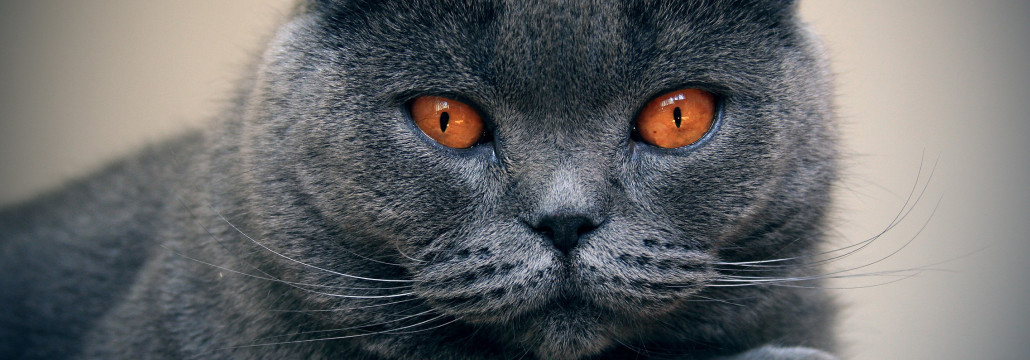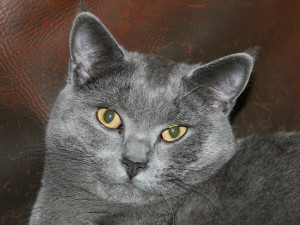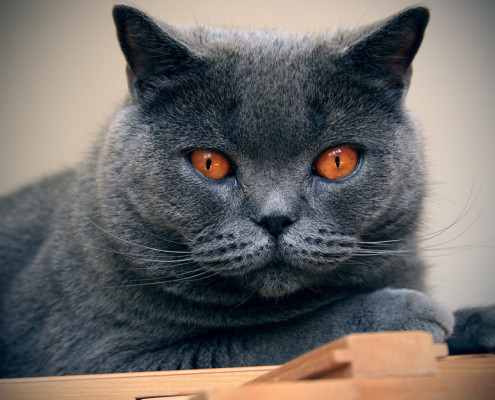Chartreux

Meoww!!
A pleasant companion cat, the Chartreaux is a good match for single people as he plays in spurts and is comfortable by himself or with his owner.
In 5 Words
- Sweet
- Athletic
- Affectionate
- Playful
- Intelligent
Snapshot
Size: Large
Weight:
Male: large: >12 lbs.
Female: large: >12 lbs.
Origin: France
Life Span: 8-13 yrs.
Colour: Blue

Characteristics
Learn About the Chartreux
Some speculated that the Chartreux breed originated in the 13th century as a mountain cat in what is now Syria. Historic records indicate that some Crusaders brought these cats back to France and left the fighting to join the Carthusian monastic order.
The breed was a favorite feline of Carthusian monks of France and an admired mouser. Some claim that the breed got its name after the world-famous Chartreuse liquors made by these monks.
This breed nearly became extinct between World War I and II, but devoted European breeders worked together.
The first of this breed came to the United States in 1971. American breeders have worked hard to improve this breed and the North American Chartreux bloodline is now regarded as the purest in the world.
Today, the Chartreux is ranked 26th in popularity among the breeds listed by the Cat Fanciers Association, which granted it championship status in 1987.
Head & Neck
Head large and broad but not round. Nose short and straight with very slight break. Muzzle narrow in relation to head, but is not pointed. Cheeks welldeveloped in adult male. Neck short, strong and heavy set. Powerful jaw especially in adult males over two years. The mouth turns up at the corners.
Penalize: Nose longer than head is wide; severe nose break or humped nose.
Ears : Small to medium ears set high on head with slightly rounded tips. Inside furnishings cover one-half of ear. Extremely fine coat on outer ear.
Eyes : Large, round and very expressive. Color ranges from pale gold to copper.
Penalize: Almond-shaped eyes; eyes too close together.
Body & Tail : Body large, well-proportioned, robust but not gross. Shoulders large and muscular. Well-developed chest giving solid sturdy appearance. Tail heavier at base, tapering slightly at base, tapering slightly to tip. Males much more massive than females. Mature males weigh from 10 to 14 pounds and mature females from 6 to 9 pounds.
Coat : Coat texture is dense, soft and plush, and of medium length.
Color : Blue only. Any shade of blue with silver highlights. Nose coat is silver gray on blue leather. Blue lips. Foot pads: gray to tan with pink undertones. Allowance to be made for faint striping and tail rings in kittens and young adults. Tail rings sometimes persist until two years of age.
Condition & Excellent : muscular condition giving the appearance of a solid muscular lithe cat. Balance Calm, affectionate, easily handled, gentle voice but seldom used.
Chartreux are less talkative than other breeds. Many Chartreux are completely mute: they purr, but cannot meow. Others have a quiet, high pitched meow or chirp which they use infrequently. This quietness can be a plus, but remember that a silent cat cannot let you know when it is lost or in trouble.
Neither gregarious nor shy, Chartreux are calmly attentive to the world, and will tend to hang back and observe, rather than rushing in. They are tolerant and gentle with strangers, small children, and other animals. They tend to withdraw from conflict rather than becoming fearful or aggressive. They accommodate themselves to most situations without complaint, travel well, and do not mind being left alone for long periods.
They are natural hunters, more interested in chasing and “killing” a toy than in romping around or wrestling in play. Even in play they are efficient, watching until the perfect moment and then letting loose with a fast and accurate pounce. They play in short spurts, sleeping and relaxing the rest of the time. They are creatures of habit and enjoy the same games and rituals day after day.
Towards those they love, Chartreux display a passionate devotion that strangers would never guess at. They prefer to be nearby, preferably getting their jowls scratched and giving loving head-bumps to their owners! They will follow you everywhere, comfort you when you are sad or ill, and prefer to sleep with you or on top of you. Their supportive, cheerful presence can be wonderful for elderly people and people living alone.
Yet this devotion is never obtrusive. They do not demand attention, and are content to sit quietly when you are busy. They have a strong sense of proper behavior and strive to be “good citizens.” They likewise appreciate courtesy from others, and remember how they have been treated. Chartreux are highly sensitive to scolding and praise, although they can sometimes be slow learners. Be patient and forgiving with this gentle breed.
Both pedigreed cats and mixed-breed cats have varying incidences of health problems that may be genetic in nature. Chartreux are generally healthy, but the following problems have been seen in the breed.
Patellar luxation is a hereditary dislocation of the kneecap that can range from mild to severe. Mild patellar luxation rarely causes problems. Severe cases cause lameness, but can be alleviated with surgery.
- Its dense, double coat benefits by weekly brushing to prevent matts. In the fall and spring, when shedding is worst, brushing should occur two to three times a week.
- Rarely needs a bath, but if one is necessary, be aware that it will be challenging to completely wet this water-resistant coat.






